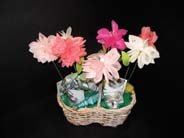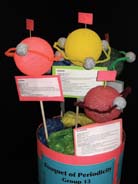from Laura Slocum, JCE High School Associate Editor
What could the three items in the title possibly have in common? For me, they represent three of the 24 different projects my students turned in February 14. In the July 2007 issue of the Journal of Chemical Education, Ami LeFevre shared her Element Project, Bouquets of Periodicity, within a longer report about the ACS High School Day Program.
In that month’s “Especially for High School Teachers” column, I wrote about how I looked forward to trying it in my classroom. This project was one of the captivating moments that carried me through the school year. I am so glad that I incorporated it into my curriculum. The students, faculty, parents, and visitors to our school were really impressed as well. These projects adorn various desks around the school and are even rotated at the school secretary’s desk in the main lobby—at present the lanthanide series in the fish bowl occupies that place of honor. Visitors to the school comment about the creative talents of our students and find the information on the projects “quite amazing”. These projects have also been good conversation starters on Grandparent’s Day and with the parents of prospective students.
For this project, students worked in assigned groups of three, with various levels of ability and creativity. I used Ami’s broad description and most of her assignment directions. I let the students choose their element group—all 18 groups were available and chosen, some twice, including the lanthanide and actinide series. Once the projects were completed and turned in, the students evaluated each team member individually, including themselves, and only shared their evaluations with me. I always incorporate individual evaluations into group projects and my students have commented that they find this quite helpful. It allows each student to openly and honestly share thoughts and opinions about themselves and the other group members in a non-threatening manner. The evaluation is also incorporated into each individual’s project grade.
Each of us needs new and fresh ideas; this was the special one for me this year. My students for next year are already talking about this project—one student has requested Group 14! When asked what she had planned for the final project, she just smiled and said, “It’s a surprise!!!” That kind of a statement is music to a teacher’s heart. It makes me want to assign this project the first day of class, just to see what she does with it.
There are additional photos, project directions, a grading rubric, and a student evaluation form online in the supplemental material. Those of you attending this summer’s Biennial Conference on Chemical Education (BCCE) at Indiana University will get to see many of these. This project will also be part of a talk in the Survivor Skills for 1st to 5th Year Chemistry Teachers symposium at the BCCE.
The July 2008 issue of JCE contains information about the much-anticipated CD-ROM containing the first 50 JCE Classroom Activities. Classroom Activities are awesome, and every teacher I meet is so grateful for the thoughtful and thorough manner in which Erica Jacobsen oversees their publication. People have often asked why there are not even more of them. I know that many of you do some really great things in your classrooms: if you shared them, others would benefit greatly. Please consider it—Erica and I are more than willing to help you put together your first Activity or Classroom Activity Connection, such as the Connection in July’s issue. Just email us and ask Erica or me.






* You can follow any responses to this entry through the RSS 2.0 feed.